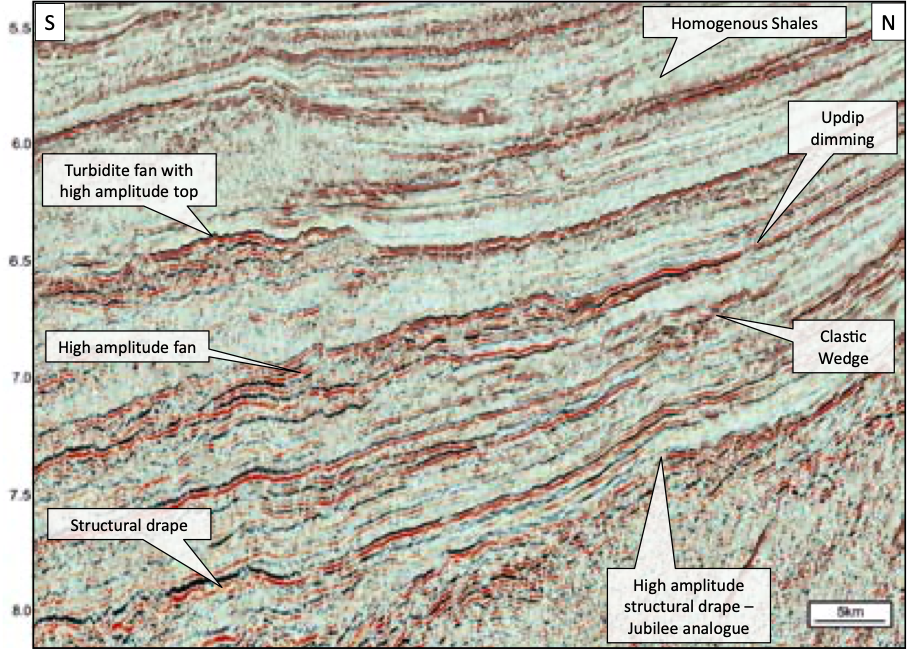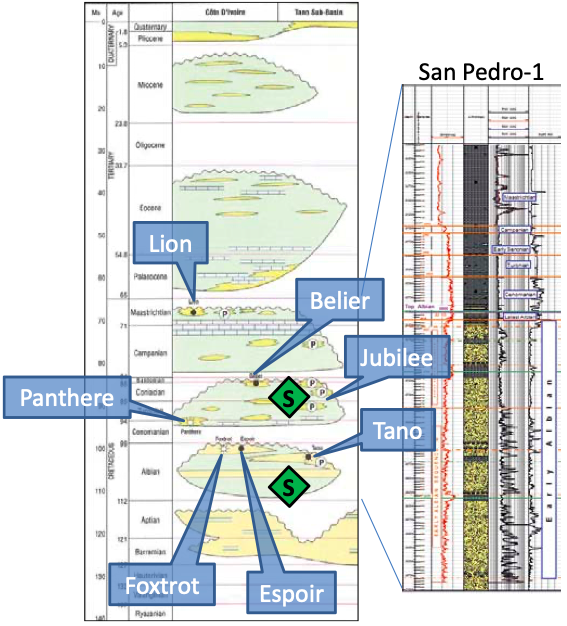

Inset: African and South American Equatorial margins free air gravity from satellite, showing conjugate tectonic elements (source: Nupetro, 2003.)
Deepwater potential in Côte d’Ivoire
Recent discoveries such as Jubilee (Ghana, 2007) and Zaedyus (French Guiana, 2011) have proven the significant remaining potential for hydrocarbons on the Equatorial Atlantic conjugate margins of West Africa and South America. Offshore Côte d’Ivoire is a major part of this tectonic province, with a huge offshore area of around 100,000 km2 which contains all the geological attributes necessary for a prolific petroleum system. Despite this, the deepwater section is underexplored, with no wells drilled off the shelf break. Several oil discoveries on the shelf of eastern Côte d’Ivoire in shallow marine clastic systems support the potential for deepwater turbidite systems of a similar age further offshore.
The western part of the shelf is also remarkably underexplored. No discoveries have yet been made in the Western offshore, where only one well (San Pedro-1, 2005) has been drilled in an area of 35,000 km2. However, recent discoveries in Sierra Leone and Liberia, such as the Mercury discovery, confirm the presence of effective source rocks along the margin to the west. Licensing activity has seen an increasing interest in the region, and where current explorers include Total, Anadarko, Lukoil and Tullow, although much acreage remains unlicensed. The water off the shelf is very deep, often between 2,000 and 4,000m, and the costs involved in drilling in such settings necessitate the requirement for high quality seismic data to accurately define exploration targets.
Petroleum systems
Offshore Côte d’Ivoire is part of the Atlantic rift system, where rifting began to propagate northwards from the South Atlantic in the latest Jurassic. Crustal stretching along transform fracture zones led to complex linked regional-scale fault systems along the margin of Côte d’Ivoire, as shown by regional seismic and gravity and magnetic data. This structuration and subsequent basin sag created a predominantly marine depositional environment from the late Albian onwards, and a series of isolated subbasins of various depths which contain potential for source rock generation.
The deep marine environment also dictates reservoir targets in many areas off the shelf, often deep-marine turbidite sands. Morrison et al. (2000) document three key play types in the Côte d’Ivoire offshore region, which can be applied across much of the margin. These are, firstly, a middle Albian terrestrial gas-prone source rock feeding Albian reservoirs; secondly a late Albian marine transgressive oil prone source rock feeding Albian reservoirs; and thirdly a Cenomanian-Turonian open marine oil-prone source rock feeding Albian and younger reservoirs. The quality of these source rocks probably increases towards deeper settings (MacGregor et al., 2003), but potential here for the deposition of reservoir sands may be reduced.
Effective exploration in this area is a spatial balancing act between the juxtaposition of effective source rocks with sufficient sediment supply from the margin. Key controls on reservoir distribution and quality are likely to be sand provenance, avulsion of major supply channels, and the extent of sand input bypassing the shelf into the deeper waters. Major sediment supply routes are likely to follow regional transform structural elements, enabling detailed prediction of reservoir location and provenance. Palaeo-channel system reconstruction is a key task in order to define the location of probable deepwater reservoirs, and can only be achieved through interpretation of regional high quality seismic datasets.
Stratigraphy
The expected stratigraphy predominantly comprises clastic sands and shales. Transform rifting in the Late Jurassic / Early Cretaceous began in a continental setting, where deep strike slip basins were filled with lacustrine shales and coarse continental clastics. These lacustrine shales form important source rocks similar in composition to the Bucomazi Formation of Angola. As rifting continued and the basins deepened, marginal marine environments began to dominate the stratigraphy, with interbedded carbonates, shallow marine clastics and shales of the mid-Cretaceous. These marine shales also form important source rocks. The end of the syn-rift stage on both the Brazilian and African margins is characterised by a major unconformity, above which rest the post-rift sediments. The stratigraphy of this section is almost entirely clastic, and shale-dominated after the Turonian when connection was made between the Atlantic and Tethys seaways.
In the early post-rift, sediment drape over the deeper rifted structures creates some of the most important deepwater reservoirs in the form of Upper Cretaceous turbidites. Basement highs are a key control on reservoir distribution and also form important trapping structures. A range of structural and stratigraphic trapping styles can be identified on deepwater seismic data, including syn-transform structural fault block traps associated with the Romanche Fracture Zone, and post transform anticlinal traps analogous to the Belier Field. Many untested trapping mechanisms can also be recognised, including ponded stratigraphic turbidites and limestone units resting on syntransform highs. Stratigraphic plays can be identified throughout the Upper Cretaceous and Paleogene sections. Burial history revealed by isopach mapping and heat flow in the basin are thought suitable for hydrocarbon generation from key source intervals of the mid-Cretaceous.
Existing successes
The near-shelf Espoir and Baobab oilfields of eastern Côte d’Ivoire have reservoirs of porous Upper Albian marine sandstones with excellent production characteristics, containing approximately 320 MMbo in total. Other key discoveries in this region include Tano, Panthère and Foxtrot, all reservoired in Cenomanian or Albian sandstones. Significant sand input to the shelf at this time, as proven in these fields, indicates the potential for deeper turbidite, fan and channel sandstones in the offshore basins.

The Jubilee Field in Ghana is now an important deepwater analogue, as similar structuration and sedimentation regimes exist all along the Equatorial margin. Jubilee was discovered with the Mahogany-1 well in a series of turbidite fans and channels of Campanian to Turonian age, with excellent production characteristics, draped over a rifted high and pinching out up-dip. The field is located some 60 km offshore in 1,100m of water just off the shelf break to the east of the Côte d’Ivoire maritime boundary. Recoverable reserves are estimated at over 600 MMb of light oil up to 35° API. On the South American margin, Zaedyus was also discovered in stacked Upper Cretaceous turbidite fans, proving up the conjugate margin analogue, and potentially containing more recoverable oil than Jubilee in a larger fan system. It is possible to identify a range of similar prospective features on PGS data, along with additional potential in a range of untested plays.
Regional insight
PGS Geostreamer and conventional data provides a crucial insight into the potential for new discoveries offshore Côte d’Ivoire, an area set for extensive deepwater exploration in the coming years. High quality imaging enables the successful characterisation of petroleum systems, in particular the ability to solve key regional issues such as deepwater reservoir deposition and timing of sediment supply. Tectonics also exerts a key control on the development of source rocks, and regional structural mapping is required to highlight generation potential. The offshore deepwater and western shelf of Côte d’Ivoire are underexplored, and will soon see an increase in exploration activity in the region as interest intensifies along both sides of the Equatorial conjugate margins of the Atlantic.
References:
MacGregor, D., Robinson, J., and Spear, G., 2003, Play fairways of the Gulf of Guinea transform margin. Geological Society of London Special Publications, 207.
Morrison, J., Burgess, C., Cornford, C., & N’Zalasse, B., 2000, Hydrocarbon system of the Abidjan margin, Côte d’Ivoire. Offshore West Africa, Fourth Annual Conference, Abidjan, 21–23 March 2000. Pennwell Publishing, Tulsa, Oklahoma.




